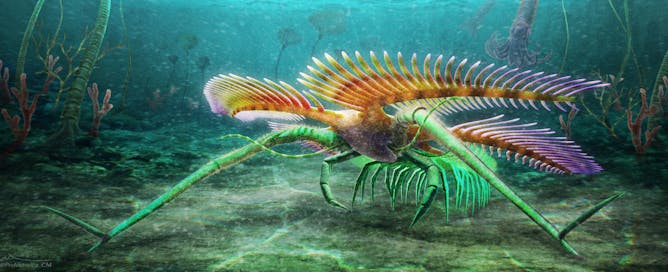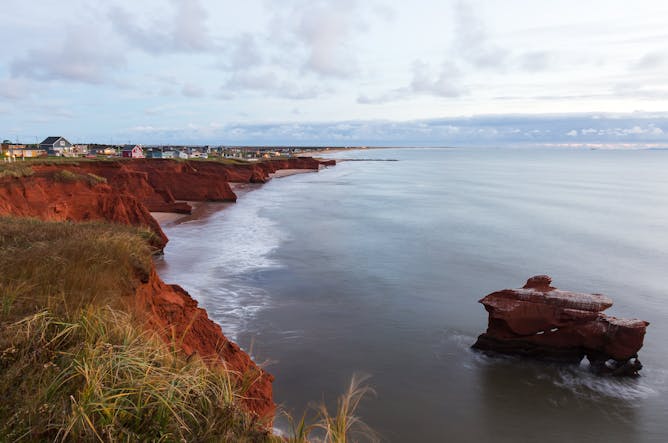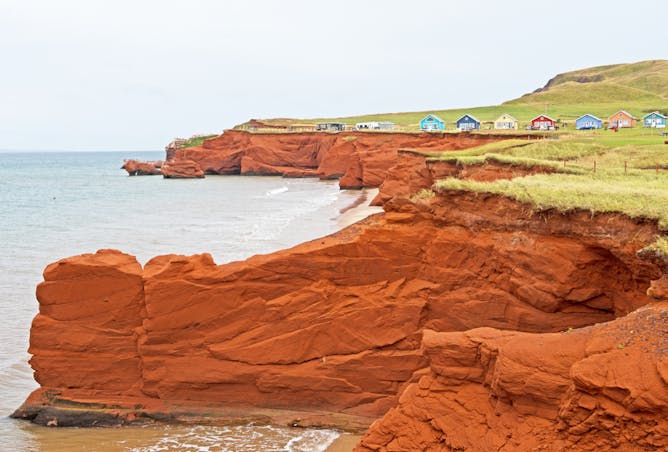|
|
|
|
Genomics has reinvigorated the field of paleontology. New discoveries are shedding light on gaps in the evolutionary timescale, allowing us to understand more about how life on Earth developed, and how different creatures came to be. One of these new findings has solved the mystery of when mammals became warm-blooded.
Today, in The Conversation Canada, Alejandro Izquierdo Lopez from the University of Toronto describes a new find: a fossil found in Ontario and held in the Royal Ontario Museum’s collection that turned out to be a marellomorph. “Despite the abundance of Marrella fossils,” he writes, “there is no consensus on where marrellomorphs place in the evolution of arthropods.”
But this particular fossil specimen reveals connections to the elongated limbs of spiders and horseshoe crabs.
Another fossil discovery has provided a theory that one fish species started evolving out of the water as one of the first tetrapods. Qikiqtania, found in the Canadian Arctic has a unique humerus bone in its fin, hinting that it might have started the move to land, only to return to the water.
Also today:
All the best.
|

|
Nehal El-Hadi
Science + Technology Editor
|
|

Tomlinsonus inhabited a shallow sea with abundant sea lilies. It probably used its stilt-like legs to move across the seafloor while looking for prey or carcasses.
(ROM/Christian McCall)
Alejandro Izquierdo Lopez, University of Toronto
Marrellomorphs are one of the rarest arthropod groups in the world. The discovery of a new fossil sheds light on this enigmatic creature.
|

Local communities, researchers, governments and businesses are working together to identify coastal erosion risks and find sustainable solutions.
(Shutterstock)
Jacob Stolle, Institut national de la recherche scientifique (INRS); Damien Pham-Van-Bang, Institut national de la recherche scientifique (INRS)
Coastal erosion along the St. Lawrence River has economic, social and cultural impacts.
|

Britain’s Home Secretary Priti Patel (left) and Rwanda’s Minister of Foreign Affairs Vincent Biruta (right) sign a deal on April 14, 2022, that would send some asylum-seekers in the U.K. thousands of miles away to Rwanda.
(AP Photo/Muhizi Olivier)
Yvonne Su, York University, Canada; Corey Robinson, Durham University
The prevailing narrative around migrant smuggling has clouded the public’s understanding of the issue by obfuscating the role smuggling plays in helping refugees gain asylum.
|

The sun at 13:32 on July 15, 2022, just as the filament that resulted in the solar flare begins to detach.
(Helioviewer)
Gonzalo José Carracedo Carballal, Centro de Astrobiología (INTA-CSIC); David Montes, Universidad Complutense de Madrid
NASA, NOAA and SpaceWeather say a coronal mass ejection will reach Earth this week. It has the potential to knock out communications in some parts of the world.
|

The protagonist at the centre of ‘Summer with the Enemy’ rides horses along the Euphrates and dreams of an equestrian future, but faces uncertainty in a society under seige.
(Ahmed Matrix/Wikimedia)
Michelle Hartman, McGill University
Three generations in a Syrian town: The English-to-Arabic translator of the novel that was a finalist for the prestigious International Prize for Arab Fiction discusses the sweeping historical novel.
|

Ukrainian women picket in Kyiv, Ukraine, in May 2022, calling for the rescue of Ukrainian fighters from the besieged Donbas city of Mariupol amid Russia’s invasion.
(AP Photo/Efrem Lukatsky)
Valerie Oosterveld, Western University
Survivors of conflict-related sexual violence in Ukraine deserve some measure of justice through co-ordinated, carefully planned action.
|
La Conversation Canada
|

Les communautés locales, les chercheurs, les gouvernements et les entreprises travaillent ensemble pour identifier les risques liés à l'érosion côtière et trouver des solutions durables.
(Shutterstock)
Jacob Stolle, Institut national de la recherche scientifique (INRS); Damien Pham-Van-Bang, Institut national de la recherche scientifique (INRS)
Les côtes du Saint-Laurent, qui ont une importance économique, sociétale et culturelle considérable, s’érodent. L’adaptation des gouvernements et des communautés locales est nécessaire et inévitable.
|
Ukraine Invasion
|
-
Alexander Hinton, Rutgers University - Newark
Russia and other countries and political regimes have a long history of forcing people to move, mostly for security and economic gains.
|
|
Business + Economy
|
-
Jolanta Burke, RCSI University of Medicine and Health Sciences
Taking time off work is important, but many people don’t take their full holiday entitlement. Here’s how to make the most of time off
|
|
Politics
|
-
Patricia Hynes, Sheffield Hallam University
Sir Mo Farah took three decades to discuss what happened to him as a child.
|
|
Science + Tech
|
-
Emma Kast, University of Cambridge; Jeremy McCormack, Goethe University Frankfurt am Main; Sora Kim, University of California, Merced
Megalodon, the world’s largest known shark species, swam the oceans long before humans existed. Its teeth are all that’s left, and they tell a story of an apex predator that vanished.
|
|
|
|
| |
| |
| |
| |
|
|
|
|
|
|
|